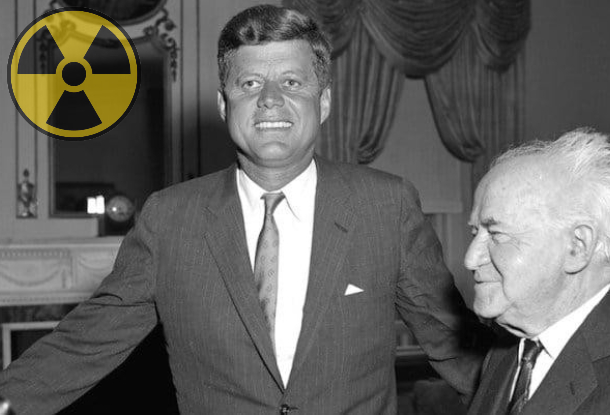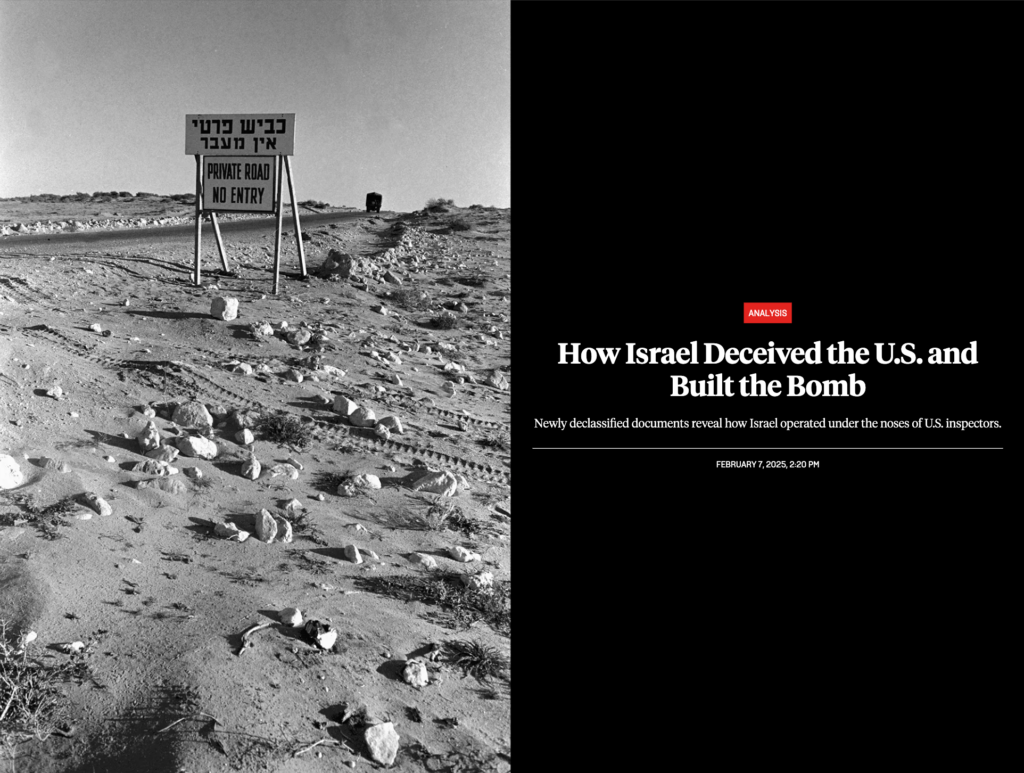from 21st Century Wire:

Israel’s Dimona nuclear project: A secret within a secret, holding the world to ransom through nuclear blackmail.
In the 1950s, Paris and Tel Aviv collaborated closely on atomic research, driven by their shared opposition to Nasser’s Egypt. This strategy is known as a policy of nuclear ambiguity in deterrence. Officially, Israel claims it does not have nuclear weapons and has not signed the Nuclear Non-Proliferation Treaty (NPT), thus avoiding International Atomic Energy Agency (IAEA) inspections. Nonetheless, it is widely acknowledged in the Middle East that Israel possesses nuclear warheads, especially after Prime Minister Ehud Olmert’s implicit admission in December 2006. In fact, Israel has had nuclear capabilities since 1967, largely due to substantial support from France, which helped it become the sixth nuclear power worldwide.
TRUTH LIVES on at https://sgtreport.tv/
Israel began its nuclear program in 1949 under Prime Minister David Ben-Gurion, but the United States, concerned about nuclear proliferation in the Middle East and the potential inclusion of China and France as nuclear powers, declined to assist. During John F. Kennedy’s presidency, the U.S. sought to convince Israel to abandon its nuclear ambitions, offering a nuclear umbrella and deterrence assurances, but these attempts were unsuccessful.
Experts estimate that the state of Israel currently possesses between 100 and 200 nuclear warheads. Its military is equipped with a comprehensive array of delivery systems capable of deploying nuclear weapons, which includes American-manufactured F-15 and F-16 bombers, in addition to various missile systems. However, did the United States genuinely fall victim to Israel’s deception?

Avner Cohen and William Burr report for Foreign Policy Magazine…
How Israel Deceived the U.S. and Built the Bomb
Newly declassified documents reveal how Israel operated under the noses of U.S. inspectors.
Iran’s nuclear activities have been on the front pages for years although it remains unclear precisely how close Tehran is to building its first bomb. Iran’s relative failure in preserving the secrecy of its weapons aspirations [to date, there is still no evidence of any Iranian nuclear weapons program] stands in sharp contrast to the experience of Israel, the first and only Middle Eastern state to acquire nuclear weapons. During the 1960s, Israel built the bomb in near-absolute secrecy—even deceiving the U.S. government about its activities and goals.
Israel’s first leader, David Ben-Gurion, initiated Israel’s nuclear project in the mid- to late- 1950s, establishing Israel’s nuclear complex at Dimona, during a period when only three countries had nuclear weapons. A decade later, on the eve of the 1967 Six-Day War, Israel secretly assembled its first nuclear devices.
Against stiff U.S. opposition, led by President John F. Kennedy, Israeli leaders were determined to reach their goals. They saw the nuclear project as a commitment to ensure the country’s future—a “never again” pledge shaped by memory of the Holocaust. Audacity, trickery, and deception were key aspects of the relentless execution of Israel’s nuclear journey.
Last month, the George Washington University’s National Security Archive posted a new Electronic Briefing Book that includes 20 documents on Israel’s nuclear project. Those reports shed light on what the U.S. government knew about Dimona’s secrets and how Israel concealed them.

IMAGE: Israeli Prime Minister David Ben-Gurion rides in a car in Washington DC, on March 10, 1960, during a state visit (Photo: Quest/Getty Images)
From the start, Israeli leaders conceived of the Dimona project as a secret within a secret.
The first secret was the 1957 French-Israeli nuclear agreement that led to the creation of the nuclear complex. The two countries negotiated the agreement confidentially because both sides were aware of its sensitivity.
And then there was a deeper secret: the large six-story underground reprocessing facility, often referred to as a chemical separation plant, that would provide a capability to produce weapons-grade plutonium and remain concealed. Very few people on both sides of the French-Israeli agreement knew that inner secret.
Until now, the evidence suggested that when the United States discovered the Dimona project in the final months of 1960, it did not know this deeper secret. U.S. internal discussions focused on assessing the nature and motivation of the project, whether it was for weapons (i.e. plutonium production), power production, or research. While some in Washington suspected from the start that the Dimona project was about weapons production, they could not prove it; there was no smoking gun.
Read More @ 21stCenturyWire.com




